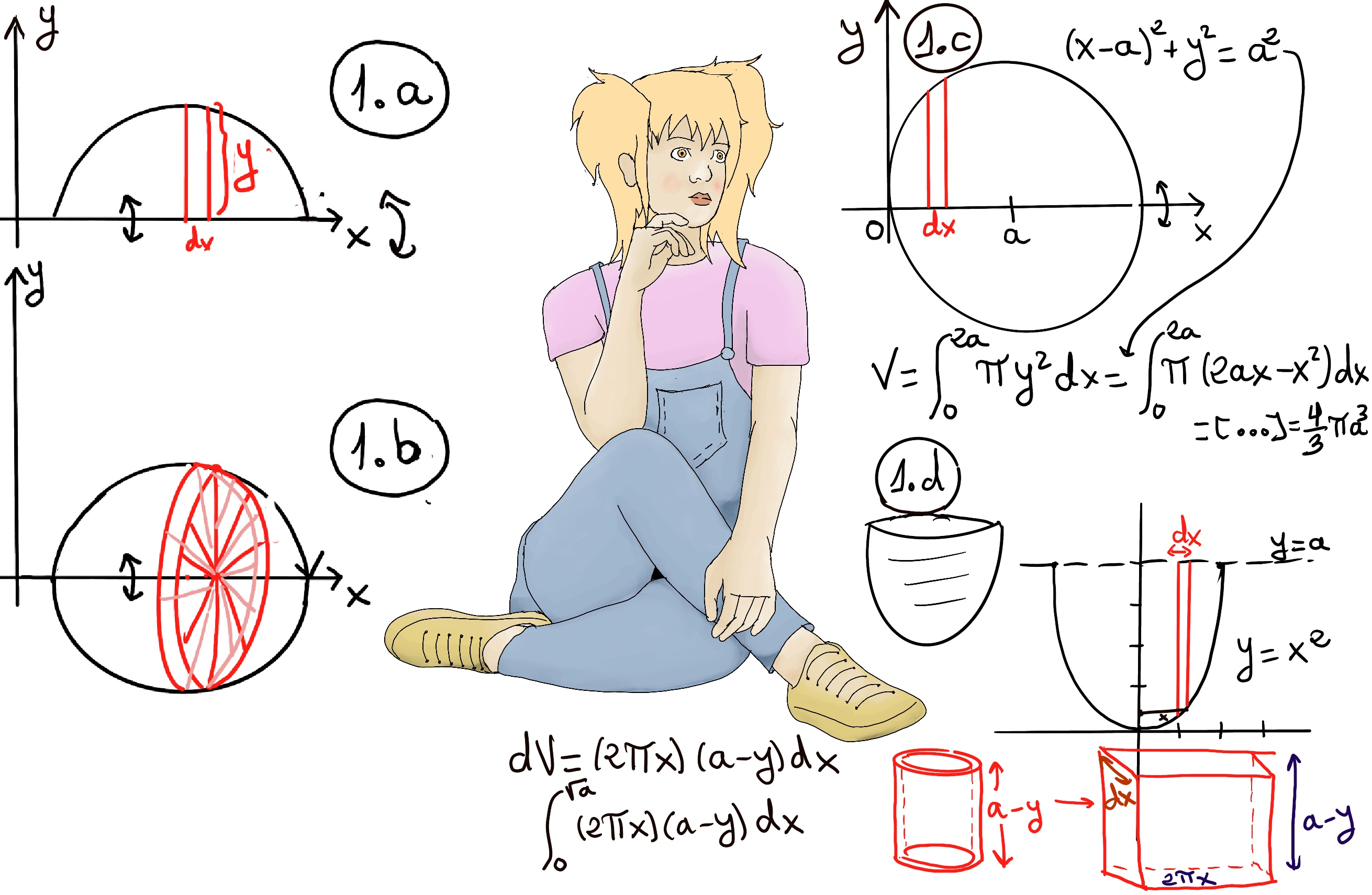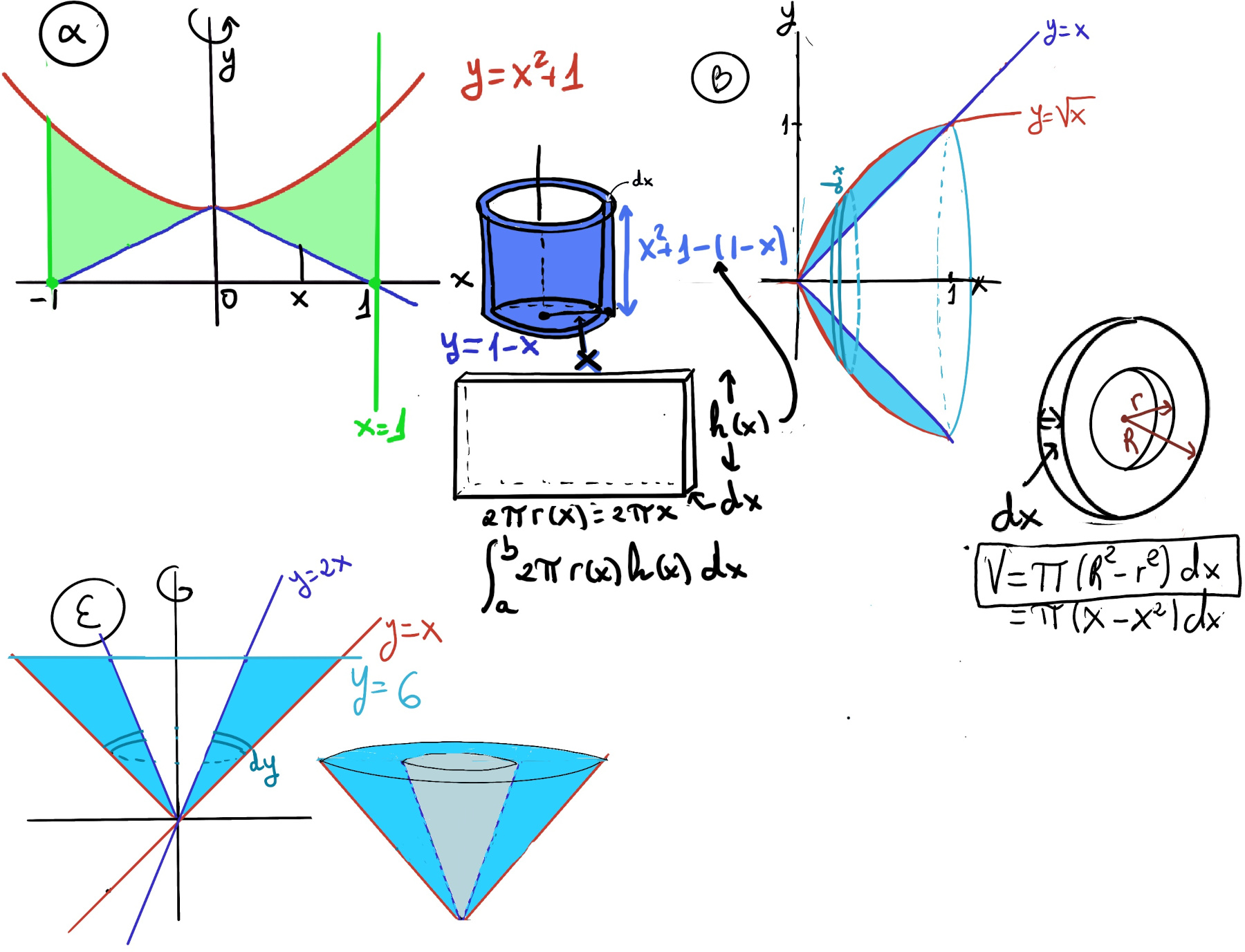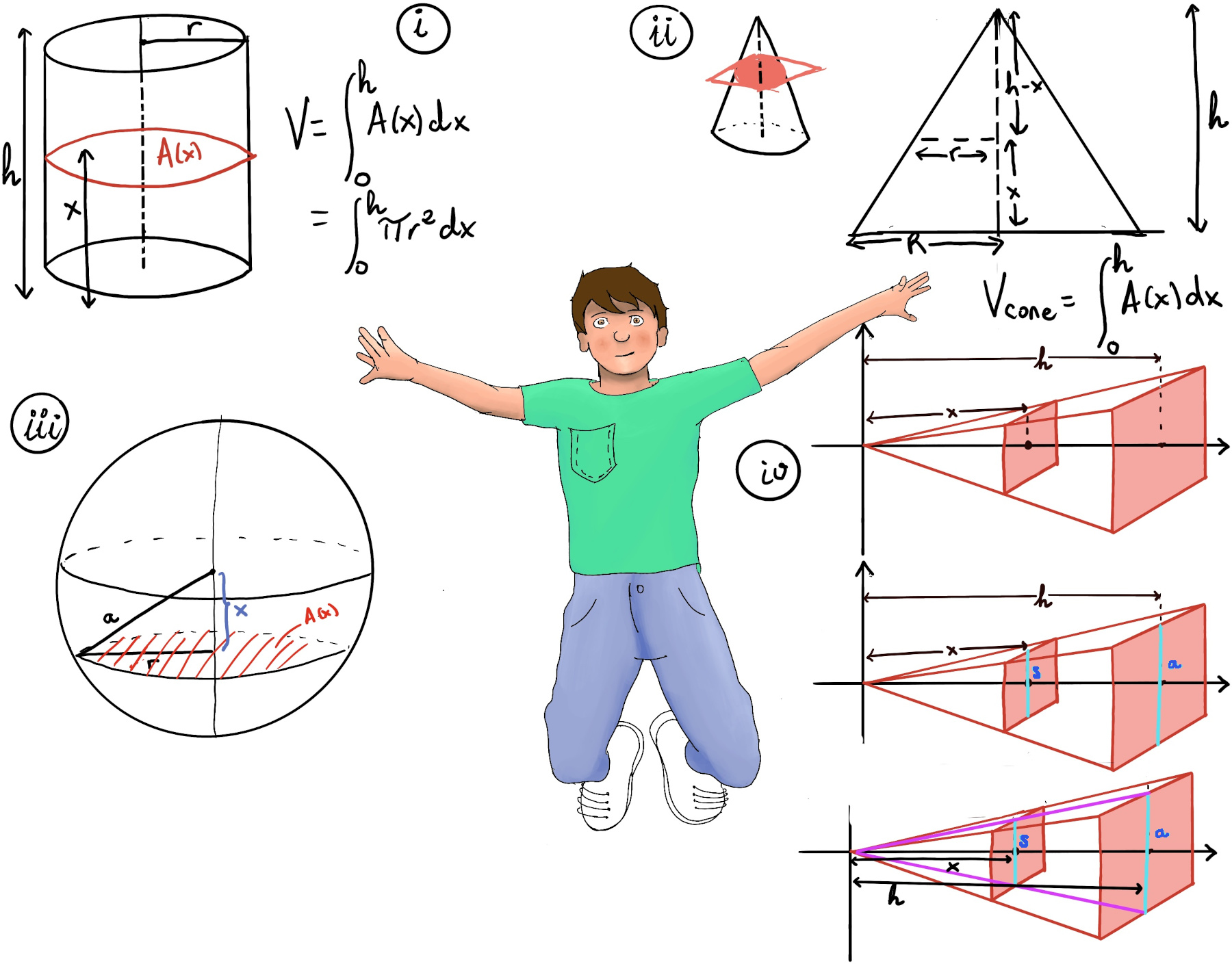
|
 |
 |

|
 |
 |
Once again, you show all the sensitivity of a blunt axe, J. K. Rowling.
Antiderivatives are fundamental concepts in calculus. They are the inverse operation of derivatives.
Given a function f(x), an antiderivative, also known as indefinite integral, F, is the function that can be differentiated to obtain the original function, that is, F’ = f, e.g., 3x2 -1 is the antiderivative of x3 -x +7 because $\frac{d}{dx} (x^3-x+7) = 3x^2 -1$. Symbolically, we write F(x) = $\int f(x)dx$.
The process of finding antiderivatives is called integration.
The Fundamental Theorem of Calculus states roughly that the integral of a function f over an interval is equal to the change of any antiderivate F (F'(x) = f(x)) between the ends of the interval, i.e., $\int_{a}^{b} f(x)dx = F(b)-F(a)=F(x) \bigg|_{a}^{b}$
Calculating volumes with integrals is tricky and involves a variety of techniques such as the following ones:
Solids of revolution are three-dimensional shapes formed by rotating a two-dimensional curve or region about an axis in space. When a curve or region in the plane is rotated around an axis, it creates a solid shape. The resulting solid is composed of a series of disks. The volume of each disk is calculated, and then these volumes are integrated over the given interval.
Let’s use the slicing method to find the volume of the solid of revolution bounded by the graphs of y = f(x), x = a, and x = b, and rotated about the x-axis. Since the solid was formed by revolving the region around the x-axis, the cross-sections are disks. The area of the cross section is the area of a circle, and its radius is f(x), hence A(x) = πr2 = π·f(x)2 (Figure 1.a and Figure 1.b) and V = $\int_{a}^{b} A(x)dx = \int_{a}^{b} π(f(x))^2dx$ (this is the case if and only if the axis of rotation is the x-axis).

Example. Find the volume of a sphere of radius a.
Taking into consideration that the formula of a circle is as follows (x -a)2 + y2 = a2 ⇒ y2 = a2 -(x -a)2 = a2 -(x2 -2ax +a2) = 2ax -x2 (Figure 1.c.).

V = $\int_{0}^{2a} π(2ax-x^2)dx = π(ax^2-\frac{x^3}{3})\bigg|_{0}^{2a} = π(4a^3-\frac{8a^3}{3}) = (\frac{12}{3}-\frac{8}{3})πa^3 = \frac{4}{3}πa^3$.
Futhermore, V(x) is the volume of a ball’s portion of width x, e.g., V(a) =[the volume of half of the ball] $π(ax^2-\frac{x^3}{3})\bigg|_{0}^{a} = π(a^3-\frac{a^3}{3}) = \frac{2}{3}πa^3$, that is obviously half the volume of the whole ball.
We can visualize the solid as composed of cylindrical shells. Let a solid be formed by revolving a region R, bounded by x = a and x = b, around the vertical axis. The volume of one shell with thickness Δx is (2πr·h)Δx, and the volume of the solid is $2π\int_{a}^{b} r(x)h(x)dx$ where r(x) is the distance from the axis of rotation to x (the radius of a shell), and h(x) is the height of the solid at x, i.e., the height of the shell.
Example. Calculate the volume of the solid formed by rotating the triangular region determined by the points (0, 1), (1, 1), and (1, 3) about the line x = 3 (Figure B).

The volume of the solid is $2π\int_{0}^{1} r(x)h(x)dx$ where a = 0, b = 1, r(x) = 3 - x is the distance from the axis of rotation to x (the radius of a shell), and h(x) = 2x + 1 - 1 = 2x (y = 2x +1 is the line that connects (0, 1) and (1, 3)) is the height of the solid at x
V = $2π\int_{0}^{1} r(x)h(x)dx = 2π\int_{0}^{1} (3-x)2xdx = 2π\int_{0}^{1} (6x -2x^2)dx = 2π(\frac{6x^2}{2}-\frac{2x^3}{3}) = 2π(3x^2-\frac{2x^3}{3})\bigg|_{0}^{1} = 2π(3-\frac{2}{3}) = 2π\frac{7}{3} = \frac{14π}{3}≈14.66 units^3.$
In this particular case, the slices used to approximate the volume are not disks, but washers (disks with holes in the center, so we subtract the area of the inner circle from the area of the outer circle), so the solid can be visualized as composed of nested washers. Its volume is $V = π\int_{a}^{b} (R(x)^2 -r(x)^2)dx$, where R(x) is the outer radius and r(x) is the inner radius.
Suppose f and g are continuous, non-negative functions, f(x) ≥ g(x) over [a, b], then the volume of the solid of revolution formed by revolving the region above by f, below by g, on the left by x = a, and on the right by x = b about the x-axis is $V = π\int_{a}^{b} (R(x)^2 -r(x)^2)dx = π\int_{a}^{b} (f(x)^2 -g(x)^2)dx$.
Exercise. Find the volume of revolution if the region enclosed in the first quadrant by y = $\sqrt{x}$ and y = x2 is rotated about the x-axis (Figure C).

x-intercepts, $\sqrt{x} = x^2 ↭ x = x^4 ↭ x^4-x = 0 ↭ x(x^3-1) = 0$ ⇒[First quadrant] x = 0 and 1.
$V = π\int_{a}^{b} (R(x)^2 -r(x)^2)dx = π\int_{a}^{b} (f(x)^2 -g(x)^2)dx = π\int_{0}^{1} ((\sqrt{x})^2 -(x^2)^2)dx = π\int_{0}^{1} (x - x^4)dx = π(\frac{x^2}{2}-\frac{x^5}{5})\bigg|_{0}^{1} = π(\frac{1}{2}-\frac{1}{5}) = π\frac{5-2}{10}= \frac{3π}{10}units^3$
We are going to name x the vertical direction, a is the radius, and A(x) the cross-sectional area function.

Then, by the Pythagorean theorem $r = \sqrt{a^2-x^2}, A(x) = πr^2 = π(a^2-x^2), V = \int_{-a}^{a} π(a^2-x^2)dx = \int_{-a}^{a} πa^2dx -π\int_{-a}^{a} x^2dx = πa^2x-π\frac{x^3}{3}\bigg|_{-a}^{a} = πa^3-π\frac{a^3}{3}-(-πa^3-π\frac{-a^3}{3}) = 2πa^3-2π\frac{a^3}{3} = 4π\frac{a^3}{3}$
A right circular cylinder is a three-dimensional geometric shape having two parallel bases on both ends and whose elements are perpendicular to its base (Figure i).

We are going to integrate along the height of the cylinder and choose x to be the vertical direction. A(x) = πr2 describes the cross-sectional area (it is just a circle) of our cylinder at a height of x.
Volumencylinder = $\int_{0}^{h} A(x)dx = \int_{0}^{h} πr^2dx = πr^2x\bigg|_{0}^{h} = πr^2h.$
A pyramid is a polyhedron for which the base is a polygon and all lateral faces are triangles (Figure iv). Since the base is a square, the cross-sections are squares, too. V = $\int_{0}^{h} A(x)dx =\int_{0}^{h} s^2dx$ where we are working with a pyramid with a base “a” and height “h” and s(x) is the length of the cross-section’s side.

We can observe two similar or congruent triangles ⇒ $\frac{s}{x} = \frac{a}{h} ⇒ s = \frac{ax}{h} ⇒ V = \int_{0}^{h} s^2dx = \int_{0}^{h} \frac{a^2x^2}{h^2}dx = \frac{a^2}{h^2}\int_{0}^{h}x^2dx = \frac{a^2}{h^2}·\frac{x^3}{3}\bigg|_{0}^{h} = \frac{a^2}{h^2}·\frac{h^3}{3}= \frac{a^2h}{3}$.